A Tapestry of Styles in Street Dance

A Tapestry of Styles in Street Dance
Street dance is an umbrella term that encompasses a multitude of dance styles, each with its unique flavor, rhythm, and history. In this blog, we'll embark on a journey through the various styles that fall under the street dance umbrella. From breakdancing in the Bronx to the emergence of Lite Feet in Harlem, and from the funk era origins of popping and locking in California to the early roots of clogging in Northern England, street dance is a vibrant tapestry of styles.
Chapter 1: Breakdancing - The Bronx Birth
1.1 The Birth of Breakdancing
Breakdancing, often known as "breaking," is a dynamic and acrobatic style that originated in the Bronx, New York City. Explore the history, elements, and cultural significance of breakdancing in this chapter.
Chapter 2: Lite Feet - The Harlem Groove
2.1 The Emergence of Lite Feet
Lite Feet is a style that embodies the spirit of New York City, particularly Harlem. With its infectious beats, energetic footwork, and party vibe, Lite Feet has become a staple of street dance parties and gatherings.
Chapter 3: Popping and Locking - The Funk Era Evolution
3.1 Popping and Locking Defined
Popping and locking are two distinct but interconnected styles that took shape during the funk era in California, USA. This chapter delves into the unique techniques and cultural influences behind popping and locking.
Chapter 4: Clogging - Early Street Dance
4.1 Clogging's Roots
Clogging, often associated with Appalachian dance, has its roots in the streets and factories of Northern England in the mid-19th century. It's a lively and rhythmic dance style that embodies the essence of street dance in its earliest forms.
In this blog, we've explored the rich tapestry of street dance styles, each with its unique history and cultural context. Stay tuned for the next blog, where we'll examine the global impact of street dance and its influence on the world of dance and beyond.